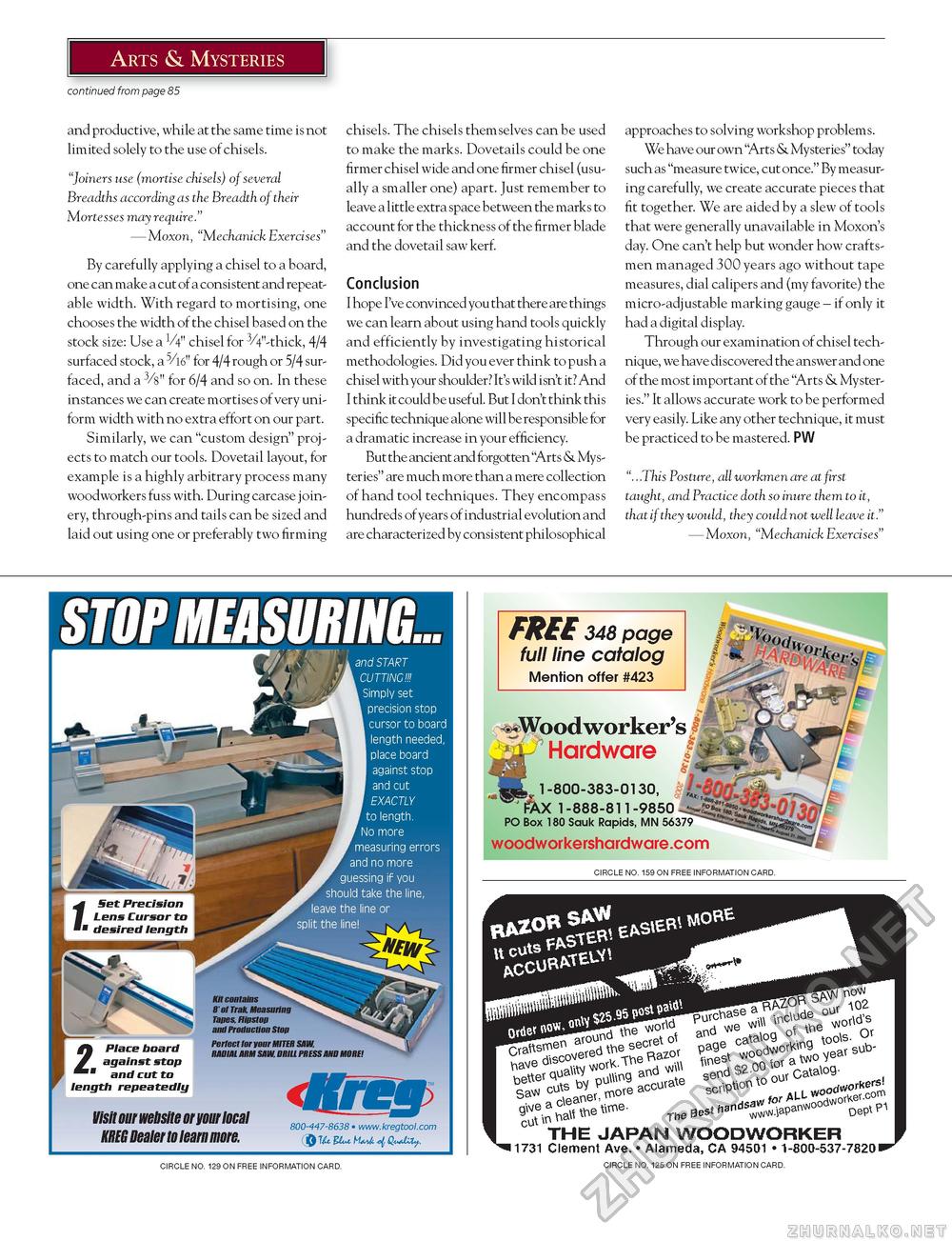Popular Woodworking 2005-06 № 148, страница 88
Arts & Mysteries continued from page 85 and productive, while at the same time is not limited solely to the use of chisels. "Joiners use (mortise chisels) of several Breadths according as the Breadth of their Mortesses may require." — Moxon, "Mechanick Exercises" By carefully applying a chisel to a board, one can make a cut of a consistent and repeat-able width. With regard to mortising, one chooses the width of the chisel based on the stock size: Use a V4" chisel for 3/4"-thick, 4/4 surfaced stock, a 5/16" for 4/4 rough or 5/4 surfaced, and a 3/s" for 6/4 and so on. In these instances we can create mortises of very uniform width with no extra effort on our part. Similarly, we can "custom design" projects to match our tools. Dovetail layout, for example is a highly arbitrary process many woodworkers fuss with. During carcase joinery, through-pins and tails can be sized and laid out using one or preferably two firming chisels. The chisels themselves can be used to make the marks. Dovetails could be one firmer chisel wide and one firmer chisel (usually a smaller one) apart. Just remember to leave a little extra space between the marks to account for the thickness of the firmer blade and the dovetail saw kerf. Conclusion I hope I've convinced you that there are things we can learn about using hand tools quickly and efficiently by investigating historical methodologies. Did you ever think to push a chisel with your shoulder? It's wild isn't it? And I think it could be useful. But I don't think this specific technique alone will be responsible for a dramatic increase in your efficiency. But the ancient and forgotten "Arts & Mysteries" are much more than a mere collection of hand tool techniques. They encompass hundreds of years of industrial evolution and are characterized by consistent philosophical approaches to solving workshop problems. We have our own "Arts & Mysteries" today such as "measure twice, cut once." By measuring carefully, we create accurate pieces that fit together. We are aided by a slew of tools that were generally unavailable in Moxon's day. One can't help but wonder how craftsmen managed 300 years ago without tape measures, dial calipers and (my favorite) the micro-adjustable marking gauge - if only it had a digital display. Through our examination of chisel technique, we have discovered the answer and one of the most important of the "Arts & Mysteries." It allows accurate work to be performed very easily. Like any other technique, it must be practiced to be mastered. PW ".. .This Posture, all workmen are at first taught, and Practice doth so inure them to it, that if they would, they could not well leave it." — Moxon, "Mechanick Exercises" FREE 348 page full line catalog Mention offer #423 # ' ISc ^Woodworker's ~ Hardware -800-383-0130, &X 1 -888-811 -9850 JT^ PO Box 180 Sauk Rapids, MN 56379 woodworkershardware.com CIRCLE NO. 159 ON FREE INFORMATION CARD. 110 ■PLMi 'Jff^r 9we 3 Se W- The h-nd^JM^01^, cut " ' -ri_itr i ai S quaW ^ and **« ;en6 ca»to9- SK h Sa S *ccUrate sexton » Tne Best pept PA CU THE JAPAN WOODWORKER 1731 Clement Ave. • Alameda, CA 94501 • 1-800-537-7820 w CIRCLE NO. 129 ON FREE INFORMATION CARD. CIRCLE NO. 125 ON FREE INFORMATION CARD. |








